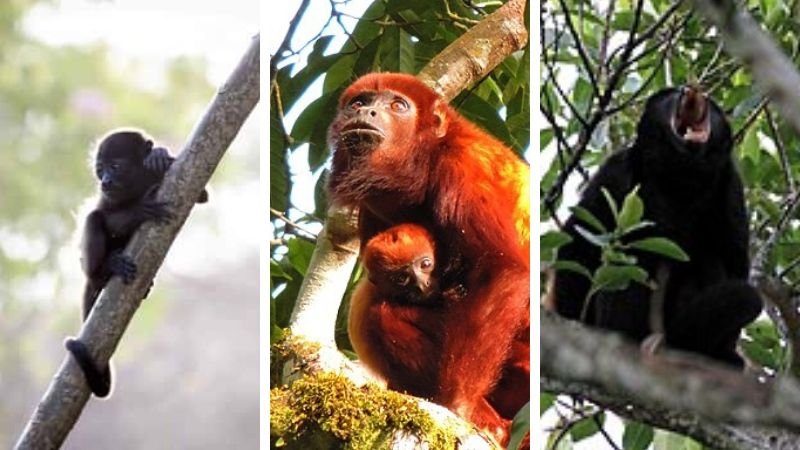
Scientific name, geographic distribution, feeding, description, behavior, reproduction. Is in danger of extinction?
The howler monkey (Alouatta spp.) is one of the best known primate species in the Neotropics. As one of the largest primates in body size, they are the second heaviest after Brachyteles (Zingenser, 1973).
Adult males can weigh an average of 7 kg and adult females 6 kg. Therefore, all howler species show sexual dimorphism in weight.
They have a wide distribution, ranging from the northern Colombian Andes to southern Bolivia. It is found from 0 to 2300m altitude, with records up to 3200m.
For this reason, it is said to be a very versatile species, using different types of habitat, and can survive in logged forests and small forest fragments (Schwarzkopf and Rylands, 1989).
Despite the recognized ability of this species to withstand habitat fragmentation and intervention, however, its presence does not guarantee the long-term stability or viability of its populations (Rylands and Keuroghlian, 1988).
They feed mainly on leaves, especially new leaves, as they are softer and have higher protein levels than mature leaves. They also consume large quantities of fruits and, to a lesser extent, buds and flowers. Of all the neotropical primates, these are the slowest and most sedentary.
Why is the Alouatta known as the Howler Monkey?
They are called howlers due to the sounds they produce, thanks to the development of their hyoid apparatus that forms a resonance cavity, evidenced by their bulging throat. This adaptation allows them to emit their powerful howl, described by Félix de Azara (1960) as “loud, sad, hoarse and unbearable.”

Source: Ereenegee / CC BY-SA
The howls produced by males at different times of the day may be for different reasons, such as to announce dawn, to announce a storm, or to announce the temporary passage through a territory.
They also use the howl to intimidate potential natural enemies, to attract females, or to maintain hierarchy over their group. Females also howl, but their howls are shorter and less loud.
Scientific name and described species (Taxonomy)
The genus Alouatta has traditionally been included in the family Cebidae (Hershkovitz, 1977). However, according to recent molecular research, a kinship of Alouatta with Ateles, Brachyteles and Lagothrix (subfamily Atelinae) has been revealed. Therefore, howlers are currently classified in the family Atelidae (subfamily Alouattinae or Mycetinae) (Defler, 2003).
The taxonomy of the genus Alouatta is still in dispute; it previously included nine species: A. palliata, A. pigra, A. belzebul, A. fusca, A. caraya, A. coibensis, A. guarida, A. nigerrima and A. seniculus (Rylands et al., 2000).
| Genus | Species |
| Alouatta | Palliata |
| Alouatta | Pigra |
| Alouatta | Belzebul |
| Alouatta | Fusca |
| Alouatta | Caraya |
| Alouatta | Coibensis |
| Alouatta | Lair |
| Alouatta | Nigerrima |
| Alouatta | Seniculus |

Source: Juan Camilo Losada Arias / CC BY-SA
Subsequently, Groves (2001; 2005) proposed 10 species, with A. macconelli, and currently the number of recognized species stands at 14 by Rylands and Mittermeier (2009), based on the work of Gregorin (2006) in which, due to coat coloration, the following were elevated to full species status: A. discolor, A. ululata A. juara, A. puruensis.
Geographical distribution
Alouatta ssp. is distributed from the north of the Andes in Colombia, starting from the western cordillera to the east and south, and includes Venezuela, the island of Trinidad, eastern Guianas, northern Brazilian Amazonia, Ecuador, Peru and western Purus in Brazil and Bolivia (Emmons and Feer, 1997). They are found in a wide range of habitats including secondary, gallery, tropical rainforest, savanna and Andean forests (Hernández-Camacho and Cooper, 1976).
Alouatta ssp. occupies all altitudinal levels of the mountain ranges, typically up to 2,300 m. In their latitudinal range, they can be found in different types of forests, both in lowland and mountain forests, and have even been found as high as 3200 meters above sea level (mountainous regions located above the cloud forest level) and the Sierra Nevada de Santa Marta (Hernández-Camacho and Cooper, 1976), which highlights their great adaptability to diverse natural environments (Neville et al., 1988).
Howler Monkey Feeding
Howler monkeys have a frugivorous-folivorous diet, ingesting fruits and foliage in proportions that vary geographically and seasonally, but frequently the proportion of foliage in the diet is 50% or more (Neves and Rylands, 1991).
Due to the high intake of foliage, which is slow to digest and provides little energy, they rest on branches in shady trees. This allows them to digest slowly and assimilate nutrients more efficiently (Stevenson et al., 2000).
Their strategy consists of minimizing the time spent in movement, moving through routes leading to their feeding trees.
On the other hand, it is well known that howler monkeys are important seed dispersers of tropical trees and commonly influence the distribution and composition of the forest remnants (Chapman, 1989; Zunino, 2001).
Description of Alouatta
Napier and Napier (1967) described the genus as follows: “In all species, the face is naked and deeply peppered. The nostrils are close together. They have a swelling under the chin with the capacity to accommodate the very specialized larynx. The swelling is below the beard of males and is more prominent in males than in females.
Its body is stocky, with a somewhat bulging abdomen. It has long and abundant hair. Its head is large in comparison to the body, with small ears, flat nose, wide, round and flat nostrils, and dark brown eyes. The jaw is prominent with a large mouth, with long hairs on the chin.
Its arms and legs are relatively long and strong. The hands have five elongated fingers, with a well-developed, non-opposable thumb and human-like nails. The tail is long, prehensile, with a bare pad on the underside near the tip.”

Source: panza.rayada / CC BY-SA
Behavior
They are social animals that form groups that generally contain more adult females than adult males (Rudran, 1979). These groups must have an appropriate size in order to maintain a stable formation (Carrera-Sánchez et al., 2003).
According to Strier et al. (1993), the development of subgroups may be the first step towards group fission. A common characteristic within the genus is that both sexes can disperse from the natal group (Rumiz, 1990).
They are monkeys that live in single- or multi-male groups with individuals of different sex-age classes (Rowe, 1996). Group size can vary between two and 22 individuals, depending on the species, although solitary males are also observed.
The hierarchy among males depends on the size of the group, and hierarchy may also occur among the females. Emigration from the natal group is more common in males than in females and varies according to species (Rowe, 1996).
Reproduction
Reproduction does not have a defined season; it can take place at any time of the year. The gestation period is about 186 days, after which the female gives birth to a single young weighing 0.4 kg.
The mother carries her young for several months until the young monkey learns which species of plants are edible and how to move safely through the vegetation.
Females reach sexual maturity at 36 months and have their first young between 40 and 46 months. Males reach maturity between 42 and 48 months.
During estrus, it is the females that approach the male, who then sniffs her genitals and tastes her urine. Usually only the dominant male copulates with females.

Is the Howler Monkey in danger of extinction?
Considering the local disappearance of certain primate species, the genus Alouatta has demonstrated that, in the face of many fragmentation factors, it is one of the primates with high behavioral and feeding strategy flexibility, and it has been reported that it can survive in very small habitats, up to 0.5 ha (Bicca-Marques and Calegaro-Marques, 1994).
Therefore, it’s possible that howlers adjust their behavior to accommodate different feeding strategies in these disturbed forest habitats.
The IUCN, in its 2011 revision of the Red List, considers the species to be of “Least Concern” (LC); however, the subspecies A. p. aequatorialis is listed as vulnerable (VU). This species is also threatened by hunting and is also used in some parts of the country as a pet.
The monkey is also part of the diet of some indigenous groups. This has led to its inclusion in Appendix I of the Convention on International Trade in Endangered Species of Wild Fauna and Flora (CITES).
Bibliography
Bicca-Marques, J.C. & Calegaro-Marques, C. 1994b. Feeding behavior of the Black Howler Monkey (Alouatta caraya) in a seminatural forest. Acta Biologica Leopoldensia, 1 (2): 64-84 Source.
Carrera-Sánchez E; Medel-Palacios, G. & Rodríguez-Luna, E. 2003. Population study of howler monkeys (Alouatta palliata mexicana) on Agaltepec Island, Veracruz, Mexico. Neotropical Primates, 11 (3): 176-180. PDF
Defler, T. 2003. Primates of Colombia. Colombia Tropical Guide Series 4. Conservation International, Bogotá, Colombia. PDF
Emmons, L. H. and F. Feer. 1997. Neotropical rainforest mammals: A field guide. Second edition. University of Chicago Press, Chicago, USA Source
Groves, C.P. 2001. Primate Taxonomy. USA & England: Smithsonian Institution Press. Source
Hernández-Camacho, J. and R. Cooper. 1976. The nonhuman primates of Colombia. Pp. 35-69 in: Thorington, R. & P. H. Helten (eds.).Neotropical primates: field studies and conservation. National Academy of Sciences, Washington D.C, USA. Source
Hershkovitz, P. 1977. Living new world monkeys (Platyrrhini). Vol 1. University of Chicago Press, Chicago, USA. Source
Napier, J. R. & Napier, P. H. 1967. A handbook of living primates. Academic Press. London. Source
Neves, A. M. and A. Rylands. 1991. Diet of a group of howling monkeys, Alouatta seniculus, in an isolated forest patch in Central Amazonia. Acta Primatologica 3: 263-274. PDF
Neville, M.K.; Glander, K.E.; Braza, F. & Rylands, A. B. 1988. The howling monkeys, genus Alouatta. In: Ecology and behavior of neotropical primates, vol.2 . R.A. Mittermeier, A.B. Rylands, A.F. Coimbra-Filho (eds.).Washington, World Wildlife Fund, pp. 349-453. Source
Rowe, N. 1996. The Pictorial Guide to the Living Primates. East Hampton, New York: Pogonias Press. Source
Rylands, A. and A. Keuroghlian. 1988. Primate populations in continuous forest and forest fragments in Central Amazonia. Acta Amazonica 18 (3-4): 291-307. Source
Rylands, A. B., R. A. Mittermeier and E. Rodríguez-Luna. 1995. A species list for the new world primates (Platyrrhini): distribution by country, endemism and conservation status according to the Mace-Land system. Neotropical Primates 3 (suppl): 113-160. Source
Rylands, A. B., H. Schneider, A. Langguth, R. A. Mittermeier, C. P. Groves and E. Rodriguez-Luna. 2000. An assessment of the diversity of new world primates. Neotropical Primates 8 (2): 61-93. PDF
Schwarzkopf, L. and A. Rylands. 1989. Primate species richness in relation to habitat structure in Amazonian rainforest fragments. Biological Conservation 48: 1-12. PDF
Stevenson, P. R., M. Quiñones and J. Ahumada. 2000. Influence of fruit availability on ecological overlap among four neotropical primates at Tinigua National Park, Colombia. Biotropica 32 (3): 533-544. PDF
Strier, K.B.; Mendes, F.D.C.; Rímoli, J.; Rímoli, A.O. 1993. Demography and social structure of one group of muriquis (Brachyteles arachnoides). International Journal of Primatology, 14 (4): 513-526. PDF
Zunino, G.E.; González, V.; Kowalewski, M.M.; Bravo, S.P. 2001. Alouatta caraya. Relations among habitat, density and social organization. Primate Report 61: 37-46. Source

Biólogo – Universidad de Oriente – núcleo de Sucre. Venezuela (2013). Profesora de Biología hasta el 2018 de la Universidad de Oriente – núcleo Bolivar. Certificada en gestión de calidad e inocuidad alimentaria ISO 22000 y gestión de la calidad en laboratorios ISO 17025. Actualmente vive en Ecuador. Senescyt Nro. 8622122546
This post is also available in:
![]() Español (Spanish)
Español (Spanish)
